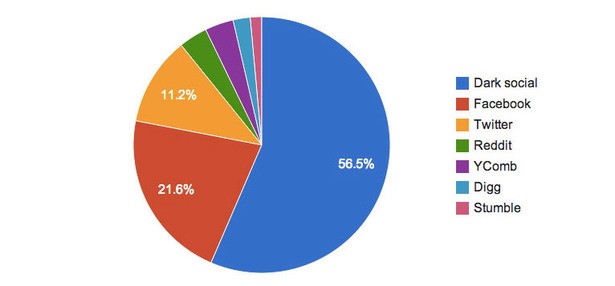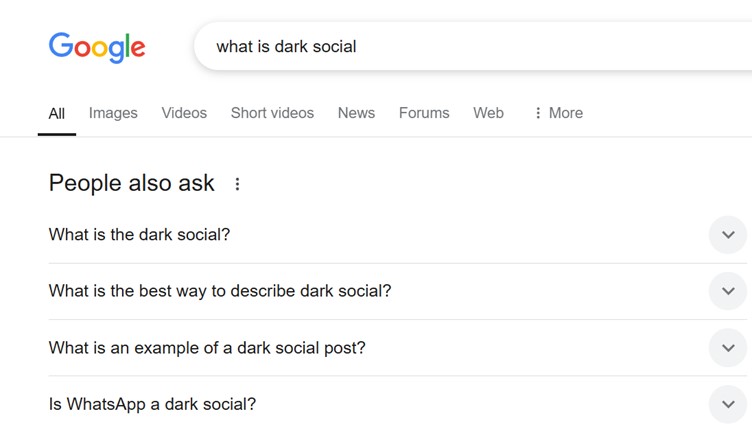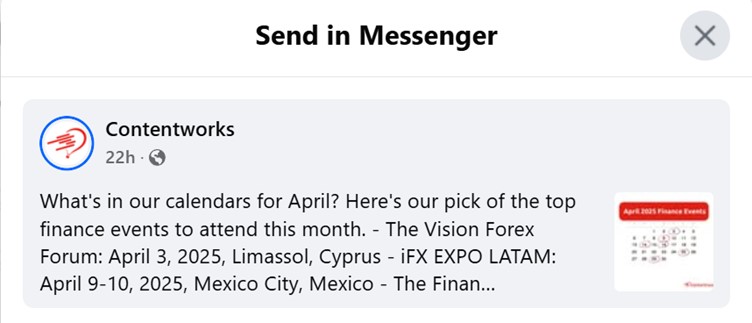Dark Social, also referred to as Direct Social is a term coined in 2012 by Alexis C. Madrigal, who authored “Dark Social: We Have the Whole History of the Web Wrong” for The Atlantic. But what is dark social, why is it a challenge and how can brands work around it? Let’s dig in.

“On the first day I saw it, this is how big of an impact dark social was having on The Atlantic.”
What Is Dark Social?
Dark social refers to the sharing of content through private channels like messaging apps, emails, and direct messages on social media. The main challenge is that even when it’s about their brand, it’s difficult for marketers to follow, track and analyse leads. Unlike public social media shares, which generate visible referral traffic, dark social interactions often appear as “direct traffic” in analytics, obscuring the true source. This can pose challenges for businesses trying to understand audience behaviours and optimise their marketing strategies. However, dark social is highly valuable, as it often reflects personal recommendations and word-of-mouth sharing, making it a powerful yet hidden driver of engagement and conversions.
Examples Of Dark Social
- Emails and text messages
- Private messaging apps (Telegram, WhatsApp, Discord, Slack)
- Private messages inside native apps (Facebook Messenger, TikTok, Instagram)
- Web traffic sources, if someone clicks a link to your website from an unsecured page. (Although HTTPS -> HTTP referral sources may be included.)
- Private social channels like closed Facebook Groups or private subreddits.
- Word of mouth including in-person conversations, radio, or podcast recommendations.
Things To Know About Dark Social
To be able to address the challenges of dark social, it’s important to know more about it. Here are some things to know about dark social and some dark social workarounds.
#1 Hidden Majority
Studies suggest that most content sharing happens through dark social channels like private messages and emails, making it a major but invisible force in digital marketing. If you are in the financial services, food and beverage, travel, or executive search industries, data estimates that 70% of social sharing is Dark. Dark Social’s growing impact is attributed to concerns over online privacy, and the popularity of private communication apps, especially amongst Gen Z. These include private messaging apps include Telegram, WhatsApp, Kik, YikYak, Slack, and Facebook Messenger, as well as texts and emails.
#2 Zero-Click Attribution And Dark Social Are Closely Linked
You might be wondering if zero click attribution counts as dark social. Zero-click attribution refers to instances where users consume content or get their answers directly from search engine results. This can be displayed as social media snippets, People Also Ask, or AI-generated responses without clicking through to a website. Similarly, dark social involves sharing through private channels, making it difficult to track its true source. Together, these trends obscure direct attribution, forcing marketers to adopt new tracking methods. They also damage website traffic by allowing users to view content without clicking through to the site.

#3 Understanding The Psychology Behind Dark Social
The psychology is deeply rooted in human behaviours, particularly in how people prefer to share and receive information. Here are some key psychological factors driving dark social interactions:
- Trust & Intimacy – People trust recommendations from close friends and family more than public posts or advertisements. Sharing through private channels like messaging apps or email feels more personal and authentic, making it more likely that recipients will engage with the content.
- Privacy & Control – Many users prefer to share content privately rather than posting it on public social media, where it can be scrutinised by a wider audience. Dark social allows for more control over the conversation, reducing the fear of judgment or unwanted engagement from strangers.
- Contextual Relevance – People share content in private conversations because it’s directly relevant to the recipient. Dark social sharing is purpose-driven, such as sending a news article to a friend who is interested in the topic.
- Fear of Algorithm Exposure – Some users avoid sharing content publicly due to concerns about how social media algorithms might use that data to target them with ads or recommendations. Although, this might not be as private as you think with algorithms picking up on everything you input online.
#4 Workarounds Do Exist
Since dark social is difficult to track using traditional analytics tools, marketers have developed makeshift strategies to gain better insights into this hidden traffic. Here are some workarounds we have tried and tested:
- Shortened URLs with Tracking Codes – By using URL shorteners or branded short links with UTM parameters, marketers can track how links are shared across private channels. For example, instead of sharing a raw link like www.example.com/blog-post, they might use bit.ly/yourlink with embedded tracking parameters to see where clicks are coming from.
- UTM (Urchin Tracking Module) codes – These can be added to URLs to track traffic sources. For instance, a company could share a link with ?utm_source=whatsapp&utm_medium=social&utm_campaign=dark_social_test to help identify when users visit from private messaging apps. Of course, experienced users may also remove the source data before sharing!
- Dark Social Sharing Buttons – Some websites now include special share buttons for private channels like WhatsApp, Messenger, and email. When users click these buttons, the links automatically include tracking codes, helping businesses understand how content is being shared outside of public social platforms.
- Advanced Analytics Tools – Some advanced tools, like Google Analytics 4, Adobe Analytics, or tools like Agorapulse, offer features specifically designed to listen and track dark social activity.
- Encouraging User Registration & Surveys – Some companies ask users where they found a particular piece of content during sign-up or checkout. Others conduct surveys asking customers how they discovered the brand, helping to uncover hidden referrals.
- Work With An Agency – Agencies like Contentworks have access to analytics and tools to help you decipher data.
The dark social trend is set to continue as more and more users demand privacy and turn away from public social media platforms. Taking time to understand dark social will, with a little planning and foresight, help you to up your game. Book a Zoom with our team to access expert social media management and reporting.

